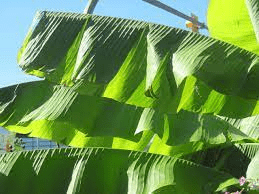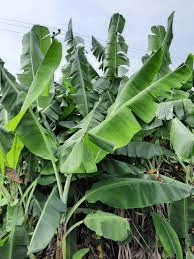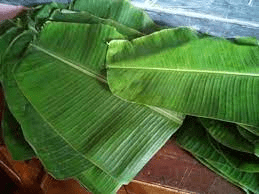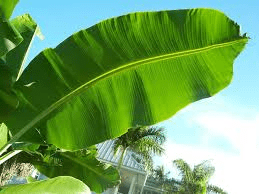Plantain Leaves refer to the large, broad leaves of the plantain plant, scientifically known as Musa spp. These leaves are a distinctive feature of the plantain plant, which belongs to the same genus as bananas. Here’s a detailed description of Plantain Leaves:
Plantain Leaves are characterized by their elongated oval shape, reaching lengths of up to several feet (1 to 3 meters) and widths of about half a meter. They typically grow in a spiral arrangement from the plant’s pseudostem, forming a canopy that provides shade and protection for the plant’s fruits below. The leaves have a smooth, waxy texture on the surface, which helps to repel water and reduce moisture loss through transpiration.
The structure of Plantain Leaves consists of several layers of plant tissue that serve various functions. The outermost layer, known as the epidermis, is a thin, protective layer of cells that helps to prevent water loss and protect the leaf from environmental stresses. Beneath the epidermis lies the mesophyll, which contains chloroplasts responsible for photosynthesis. This layer is where the majority of the leaf’s green pigment, chlorophyll, is concentrated, enabling the plant to convert sunlight into chemical energy.
Within the mesophyll, there are specialized cells called stomata, which are small openings that regulate gas exchange. Stomata allow carbon dioxide to enter the leaf for photosynthesis while enabling oxygen and water vapor to exit. This process is essential for the plant’s metabolism and growth.
Plantain Leaves play a crucial role in the plant’s life cycle and ecosystem. They capture sunlight and convert it into energy through photosynthesis, providing the plant with carbohydrates and oxygen. These leaves also contribute to the plant’s overall resilience by shielding the fruits from excessive sunlight and providing a microclimate that promotes fruit development.
Culturally and traditionally, Plantain Leaves have various uses beyond their biological functions. In many tropical regions where plantains are grown, the leaves are utilized in cooking and food preparation. They are commonly used as natural wrappers for steaming or baking foods, such as tamales or traditional dishes like pasteles. The leaves impart a subtle flavor and aroma to the foods they wrap, enhancing the overall culinary experience.
Moreover, Plantain Leaves have found applications in traditional medicine and as eco-friendly packaging materials. Extracts from the leaves have been studied for their potential health benefits, including antioxidant and anti-inflammatory properties. In some cultures, the leaves are also used for their antimicrobial properties, serving as natural bandages for minor cuts and wounds.
In conclusion, Plantain Leaves are not just functional components of the plantain plant but also versatile resources with cultural, culinary, and potential medicinal significance. Their structural adaptations enable them to fulfill critical roles in the plant’s physiology while offering practical uses in various human activities and traditions. Understanding the anatomy and functions of Plantain Leaves enhances our appreciation of their ecological importance and their diverse contributions to human societies worldwide.
The Economic Importance and Uses of Plantain Leaves

1. Medicinal Uses: Plantain leaves have long been used in traditional medicine for their healing properties, treating wounds, insect bites, and skin irritations.
2. Culinary Use: In some cultures, plantain leaves are used as natural wrappers for cooking and steaming food, imparting a subtle flavor.
3. Herbal Teas: Infusions made from plantain leaves are consumed for their medicinal benefits, such as soothing coughs and sore throats.
4. Livestock Feed: Plantain leaves are used as fodder for livestock, providing a nutritious supplement to their diet.
5. Soil Improvement: Leaves are used as mulch or composted to enrich soil with organic matter and nutrients.
6. Craft and Art: Plantain leaves are used in crafts such as weaving mats, baskets, and traditional hats, supporting local artisanal industries.
7. Environmental Benefits: Plantain leaves contribute to biodiversity and ecosystem health, providing habitat for beneficial insects and microorganisms.
8. Traditional Rituals: Leaves are used in ceremonies and rituals in many cultures, symbolizing fertility, protection, and spiritual cleansing.
9. Pest Control: Extracts from plantain leaves are used as natural pesticides and insect repellents in organic farming.
10. Educational Tools: Plantain leaves are used in botanical studies and educational settings to teach about plant morphology and ecology.
11. Biofuel Production: Research is exploring the potential of plantain leaves as a biomass source for biofuel production, contributing to renewable energy solutions.
12. Papermaking: Fibers from plantain leaves can be used in paper production, providing a sustainable alternative to wood-based paper.
13. Animal Bedding: Dried plantain leaves are used as bedding material for animals, providing comfort and absorbing moisture.
14. Aesthetic Purposes: Plantain leaves are valued for their aesthetic appeal in landscaping and gardening, used as foliage in decorative arrangements.
15. Cultural Significance: Plantain leaves hold cultural significance in various rituals, ceremonies, and traditional practices worldwide.
16. Textile Dyeing: Extracts from plantain leaves are used to dye fabrics and textiles naturally, creating vibrant colors.
17. Pharmaceutical Industry: Active compounds from plantain leaves are used in pharmaceutical preparations for their anti-inflammatory and antimicrobial properties.
18. Biomass Feedstock: Plantain leaves can be used as a feedstock for biogas production, contributing to renewable energy generation.
Read Also: Earthen Pond Management: Steps to take before putting the Fish in the Water
The Products and By-products That Can Be Derived From Plantain Leaves

1. Medicinal Extracts: Active compounds extracted from plantain leaves for use in herbal medicine and pharmaceuticals.
2. Herbal Teas: Infusions made from dried plantain leaves for their medicinal benefits and soothing properties.
3. Livestock Feed: Fresh or dried plantain leaves used as fodder for livestock and poultry.
4. Craft Materials: Leaves used in weaving mats, baskets, and traditional handicrafts.
5. Environmental Mulch: Leaves used as mulch to suppress weeds and retain soil moisture.
6. Organic Fertilizer: Composted plantain leaves used to improve soil fertility and structure.
7. Pest Repellent: Extracts used as natural pesticides and insect repellents in organic farming.
8. Paper Fiber: Fibers from plantain leaves used in papermaking as a sustainable alternative to wood pulp.
9. Animal Bedding: Dried plantain leaves used as bedding material for animals.
10. Biofuel Production: Plantain leaves processed for biomass to produce biofuels.
11. Aesthetic Purposes: Used in landscaping and gardening for their decorative foliage.
12. Textile Dyes: Natural dyes extracted from plantain leaves for coloring fabrics.
13. Pharmaceutical Uses: Active compounds used in pharmaceuticals for medicinal purposes.
14. Educational Tools: Used in botanical studies and educational settings.
15. Cultural Practices: Used in rituals and ceremonies for symbolic purposes.
16. Soil Improvement: Mulched or composted to enrich soil nutrients.
17. Biomass Energy: Used as feedstock for biogas production.
18. Horticultural Applications: Used in nurseries and gardens for plant protection and growth enhancement.
Read Also: The Quantity of Fingerlings/Juveniles to Start your Fish Farm with
Frequently Asked Questions (FAQ’s) About Plantain Leaves

1. What are plantain leaves?
Plantain leaves are the broad, green leaves of the plantain plant, known for their medicinal, culinary, and cultural uses.
2. How are plantain leaves used in traditional medicine?
Plantain leaves are used to treat wounds, insect bites, and skin irritations due to their anti-inflammatory and antimicrobial properties.
3. Can you eat plantain leaves?
While not commonly eaten directly, plantain leaves are used as natural wrappers for cooking food in some cultures, imparting a subtle flavor.
4. What are the benefits of using plantain leaves in gardening?
Plantain leaves improve soil fertility as mulch or compost, provide natural pest control, and support biodiversity in gardens.
5. How are plantain leaves used in crafts and art?
Plantain leaves are woven into mats, baskets, and traditional handicrafts, supporting local artisanal industries and cultural practices.
6. Are plantain leaves environmentally friendly?
Yes, plantain leaves are biodegradable and contribute to sustainable practices in agriculture, crafts, and environmental conservation.
7. How do plantain leaves contribute to biodiversity?
Plantain leaves provide habitat for beneficial insects and microorganisms, supporting ecosystem health and biodiversity.
8. Are plantain leaves used in biofuel production?
Research is exploring the potential of plantain leaves as a biomass source for biofuel production, contributing to renewable energy solutions.
9. What cultural significance do plantain leaves have?
Plantain leaves hold cultural significance in rituals, ceremonies, and traditional practices worldwide, symbolizing fertility, protection, and spiritual cleansing.
10. Can plantain leaves be used in textile production?
Yes, extracts from plantain leaves are used to naturally dye fabrics and textiles, creating vibrant colors without synthetic chemicals.

